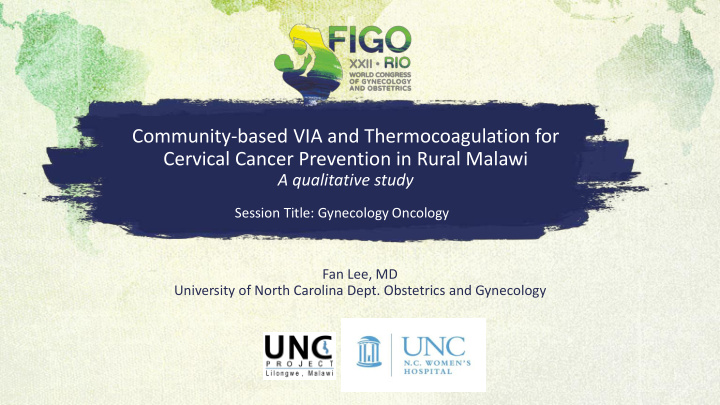



Community-based VIA and Thermocoagulation for Cervical Cancer Prevention in Rural Malawi A qualitative study Session Title: Gynecology Oncology Fan Lee, MD University of North Carolina Dept. Obstetrics and Gynecology
Declaration of Good Standing and Conflict of Interest Disclosure My presentation complies with FIGO’s policy for declaration of good standing and conflict of interest disclosure; I do not have a financial interest in any product or service related to my presentation; My participation at this Congress is supported by: - University of North Carolina Office of International affairs
Learning objective Gain insight into perspectives of women in rural Lilongwe in regards to cervical cancer screening: Barriers Motivations Experiences
BACKGROUND Malawi has the highest age- standardize incident rate in the world. ▪ Incidence: 75 per 100,000 ▪ Mortality: 49 per 100,000
BACKGROUND Screen-and-treat cervical ca prevention: Visual inspection with acetic acid (VIA) and Cryotherapy Limitations: Thermocoagulation: Access to screening facilities Heat to destroy cells Cost & availability of gas Safety and efficacy comparable to High lost to follow-up cryotherapy
OBJECTIVES Community-Based Cervical Cancer Screening with VIA and Thermocoagulation, a pilot program (Chinula et. al ) • To assess safety, efficacy and acceptability Qualitative Sub-study: ▪ To explore the perceptions and experiences of participants ▪ To assess the feasibility and acceptability of this intervention
METHODS July – August, 2017 in rural Lilongwe District • 415 women screened with VIA • 29 women treated with Thermocoagulation • 17 in-depth interviews, semi-structured • Audiotaped, translated & transcribed • Content analysis • NVIVO • Constant comparative analysis
RESULTS: DEMOGRAPHICS
RESULTS: KNOWLEDGE & PERCEPTION ➢ There was low baseline knowledge, fatalistic views of cervical cancer and myths/misconception of screening. “Cervical cancer is a very deadly disease, everyone is afraid of it more than AIDS” (ID233, age 40) ➢ Participants commonly expressed desire to “know one’s status,” as the main reason for partaking in screening. “ I wanted to know the condition of my body. you can just be staying and never be certain that you are ok or not. So this time I thought it wise to go and get screened” (ID269, age 26)
RESULTS: EXPERIENCE OF SCREEN & TREAT ➢ All participants expressed an overwhelmingly positive experience Appreciations: Concerns: ▪ Healthcare workers coming to village ▪ Noisy equipment ▪ Felt well counseled ▪ Long duration ▪ Immediate treatment offered ▪ Worry of positive result ▪ Comfortable during procedure ▪ Vaginal discharge
RESULTS: BARRIERS ➢ Transportation – expressed by EVERY participant ➢ Male partners were viewed as both a barrier AND as an important source of support “After I told him [about the screening], he did not understand….We managed to stay for 2 weeks without sex but that was because he was angry. The third week however things got worse and then we had sex. So it only worked for 2 weeks and that was because he was angry.” (ID329, age 41)
DISCUSSION / KEY MESSAGES ➢ Community-based, screen-and-treat with Thermocoagulation was widely accepted by participants ➢ Transportation is a major barrier to follow-up ➢ Thorough counseling and positive experience with healthcare providers helped participants understand the purpose and importance of screening ➢ Education campaigns should also target men to promote male partner support ➢ Future considerations for reaching rural women should include self collected vaginal swabs for HPV testing
Thank you THANKYOU Participants of this study UNC Project Malawi and study staff Lilongwe District Health Office Mentors: Drs: Jennifer Tang, Lameck Chinula, Benjamin Chi, Jes Morse Study Team: Agatha Bula, John Chopola, Clement Mpange, Laura Limarzi UNC Office of International Affairs UNC OBGYN Residency FIGO
REFERENCES 1. Globocan 2012: Estimated Cancer Incidence, Mortality and Prevalence Worldwide in 2012 http://globocan.iarc.fr/Pages/fact_sheets_population.aspx 2. Ferlay J SI, Ervik M, Dikshit R, Eser S, Mathers C, Rebelo M, Parkin DM, Forman D, Bray F.GLOBOCAN 2012 v1.0, Cancer Incidence and Mortality Worldwide: IARC CancerBase No. 11. Lyon, France: International Agency for Research on Cancer; 2013. 3. Maseko, F. C., Chirwa, M. L., & Muula, A. S. (2014). Client satisfaction with cervical cancer screening in Malawi. BMC health services research , 14 (1), 420. 4. Campbell, C., Kafwafwa, S., Brown, H., Walker, G., Madetsa, B., Deeny, M., ... & Cubie, H. A. (2016). Use of thermo ‐coagulation as an alternative treatment modality in a ‘screen‐ and ‐treat’programme of cervical screening in rural Malawi. International journal of cancer , 139 (4), 908-915. 5. Msyamboza, K. P., Phiri, T., Sichali, W., Kwenda, W., & Kachale, F. (2016). Cervical cancer screening uptake and challenges in Malawi from 2011 to 2015: retrospective cohort study. BMC Public Health , 16 (1), 806. 6. Dolman, L., Sauvaget, C., Muwonge, R., & Sankaranarayanan, R. (2014). Meta ‐ analysis of the efficacy of cold coagulation as a treatment method for cervical intraepithelial neoplasia: a systematic review. BJOG: An International Journal of Obstetrics & Gynaecology , 121 (8), 929-942. 7. Sauvaget, C., Muwonge, R., & Sankaranarayanan, R. (2013). Meta ‐ analysis of the effectiveness of cryotherapy in the treatment of cervical intraepithelial neoplasia. International Journal of Gynecology & Obstetrics , 120 (3), 218-223. 8. Viviano, M., Kenfack, B., Catarino, R., Tincho, E., Temogne, L., Benski, A. C., ... & Petignat, P. (2017). Feasibility of thermocoagulation in a screen-and-treat approach for the treatment of cervical precancerous lesions in sub-Saharan Africa. BMC women's health , 17 (1), 2.
QUESTIONS? “I will use my story and experience as a tool to encourage my fellow women to go for cervical cancer screening, because I am a living example.” -ID240, age 36
Recommend
More recommend